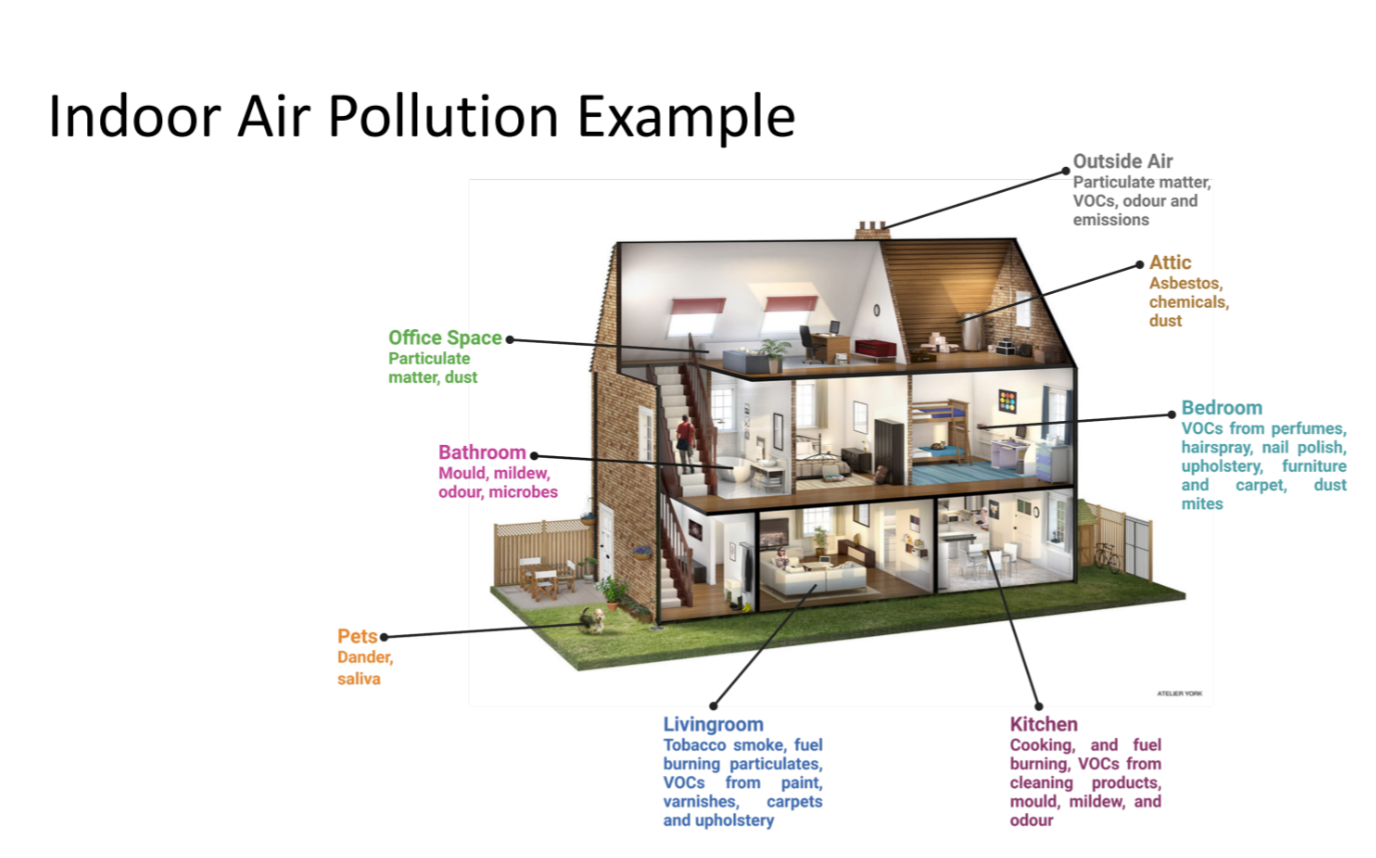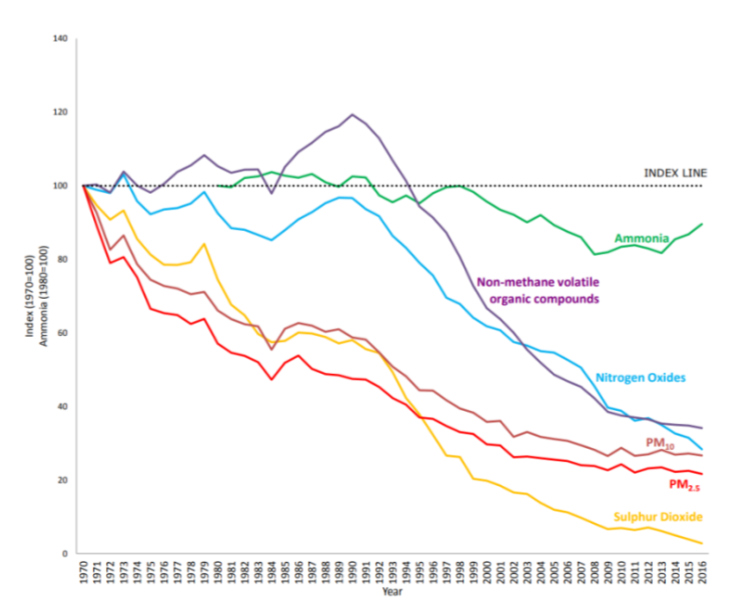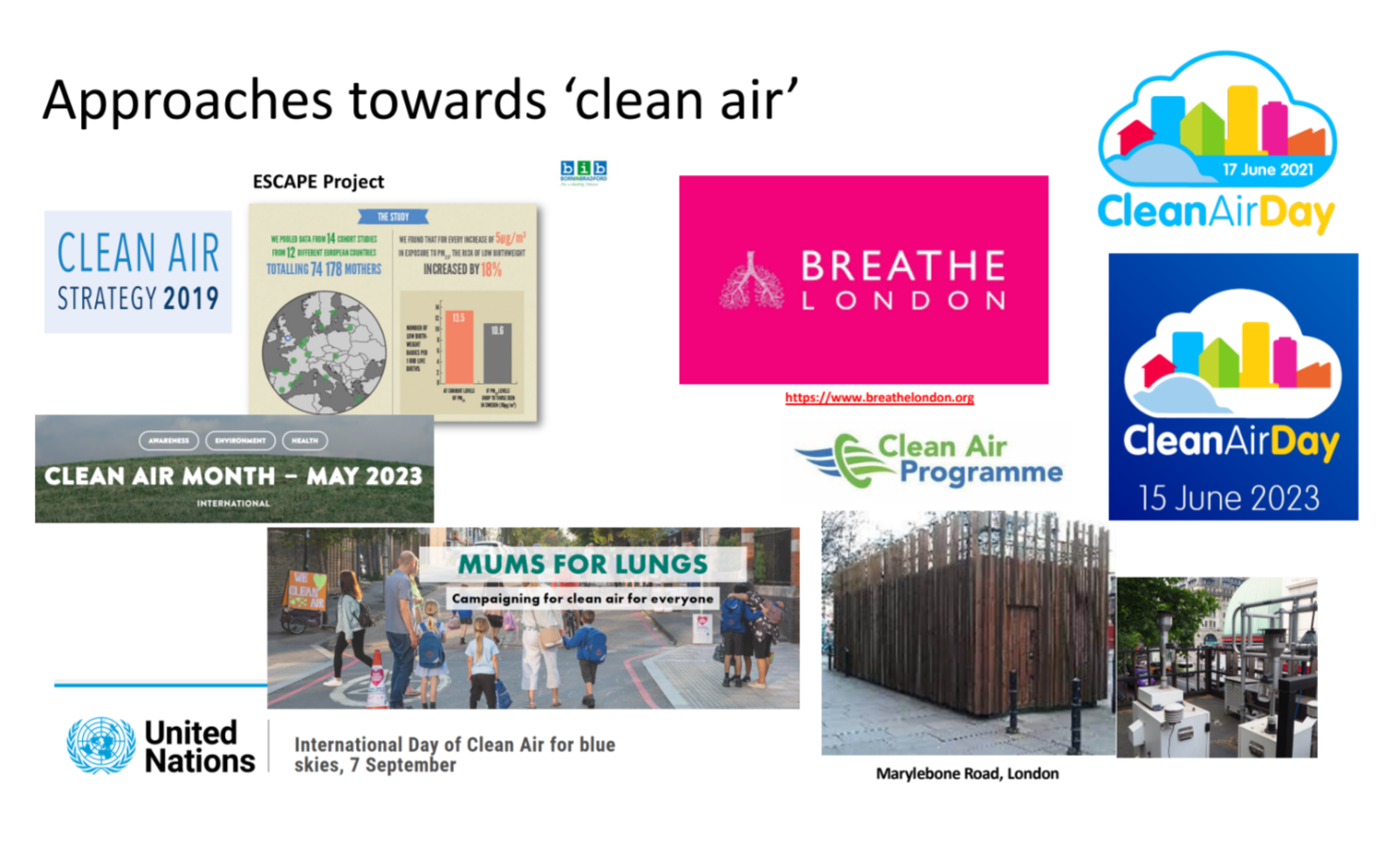Air pollution
1/25
There's no tags or description
Looks like no tags are added yet.
Name | Mastery | Learn | Test | Matching | Spaced |
|---|
No study sessions yet.
26 Terms
Air pollution definition
Presence of harmful substances (e.g. particles, gases) in the air that negatively affect health or the environment
Air pollution vs climate change
Air pollution: Presence of harmful substances in the air
Climate change: Long-term shift in global or regional climate patterns
Air quality meaning
Air quality: how clean or polluted the air is, based on the presence and concentration of pollutants such as NO₂, SO₂, PM2.5, PM10, and ozone. Good air quality means low levels of harmful pollutants, while poor air quality means high concentrations that may affect health.
🧠 Key point:
Air quality ≠ air pollution.
→ Air pollution contributes to air quality, but they are not the same thing.
What are the major sources of air pollution?
Outdoor air pollution sources (6)
Industry
Chemical manufacturing, waste processing, mining operations.
Transport
Car exhaust, trains, boats, aircraft.
🚫 Non-exhaust emissions (brake/tyre wear) are a bigger contributor than exhaust, especially in electric vehicles.
Humans (Lifestyle)
Use of cars, heating, poor waste practices, frequent consumption patterns.
Natural Sources
Volcanoes, wildfires, tsunamis — release particulate matter and gases.
Animals
Livestock release methane and ammonia (especially relevant in farming regions).
Environment
Naturally occurring elements like pollen, spores, wind-blown dust, gases.
What are the major sources of air pollution?
Indoor air pollution sources (9)
Solid Fuels (for heating/cooking)
Wood, coal, dung, crop waste – used especially in LMICs or fuel-poor areas.
Cooking Methods
Frying and grilling produce more pollutants than microwaving or boiling.
🔥 Tip from Prof: “Don’t fry sausages—grill them!”
Heating Appliances
Gas stoves, wood/coal fires, radiators — emit nitrogen dioxide and particulates.
Cleaning & Cosmetic Products
Contain VOCs (volatile organic compounds) like ethanol, limonene.
Includes air fresheners, sprays, polish, shower cleaners.
Mould and Damp
Especially harmful in poorly ventilated homes (e.g. toddler death in UK due to black mould).
Furniture & Textiles
Emission of micro/nanoplastics, VOCs from upholstery, carpets, etc.
Pets
Dander, fur, microbial emissions (unless it’s a fish 🐠).
Ventilation Issues
Poor airflow traps indoor pollutants; opening windows doesn’t always help due to boundary effects (indoor-outdoor mixing).
Everyday Spaces
Gyms (sweat + equipment plastics), public transport, cinemas, classrooms all contribute to cumulative exposure
(Outdoor air pollution is visible, but indoor is where we live, breathe, and absorb—yet we ignore it most)
Who was Ella Adoo-Kissi-Debrah and why is her case important?
Ella was the first person to have air pollution officially listed as a cause of death, highlighting its serious impact on child health and the need for medical awareness
What is the Daily Air Quality Index (DAQI)?
The DAQI is a public-facing tool that shows how clean or polluted the air is on a daily basis.
It uses colour-coded levels (e.g. green = good, red = very unhealthy) to inform the public.
(Where it’s used:
UK-wide, with monitoring stations like the one on Marylebone Road, London, feeding data into it.
Also accessible on weather apps via the Air Quality Index (AQI) dot.)

What does DAQI measure? (5)
It adapts according to what?
Nitrogen Dioxide (NO₂)
Sulphur Dioxide (SO₂)
Ozone (O₃)
Particulate Matter <2.5μm (PM2.5)
Particulate Matter <10μm (PM10)
Will adapt depending on metereological events
Limitations of DAQI (5)
Only models one pollutant at a time — doesn’t account for co-exposures.
Based on "healthy" populations — doesn't represent vulnerable groups.
Doesn’t factor in lag time — assumes immediate health effects.
Mostly useful for short-term exposure awareness, not chronic health risks.
Colour rarely changes, leading to public apathy or misinterpretation of risk.
Why is indoor air pollution often overlooked but more dangerous than outdoor? (2)
People spend ~87% of time indoors, where hidden sources like VOCs (cleaning products, sprays), mould, combustion, and poor ventilation build up — posing long-term health risks.
🧠 Examples: Kitchen (fuel, VOCs), bathroom (mould), bedroom (perfumes, dust mites), living room (paint, tobacco), pets (dander), attic (asbestos).

How have air pollutant levels changed over time (1970–2016)?
Most pollutants (e.g. SO₂, PM₂.₅, NOₓ) have decreased, but ammonia has increased due to agriculture.

What is PM₁₀, what does it contain, and why is it a health concern?
PM₁₀ is particulate matter ≤10μm in diameter, collected at 50% efficiency using a size-selective inlet.
It has a complex composition, including:
Carbon particulates
Transition metals
Endotoxins
Dust and pollen
PM₁₀ is linked to adverse health effects — especially due to its ultrafine components, which may be the main cause of toxicity.
However, the differential toxicities by source are still unclear.
How do particulate air pollutants affect the lungs (2) and why are ultrafine particles considered especially harmful? (4)
Particulate air pollution can cause acute and chronic respiratory damage, (as shown in historical events like the 1952 London smog)
Inhaled particles such as PM₁₀ and PM₂.₅ can lead to conditions like coal miner's lung, silicosis, and asbestosis.
Ultrafine particles (<0.1 μm) are particularly dangerous because:
They penetrate deepest into the lungs, reaching alveoli.
They are associated with reduced lung function (e.g., peak expiratory flow).
Their complex composition includes toxic components like carbon cores, organic species, heavy metals, and sulphates.
Toxicity varies depending on the particle’s source and composition (e.g., diesel, oil ash).
(Studies (Seaton et al., 1995; Peters et al., 1997; Oberdorster et al., 2005) show a strong correlation between exposure to ultrafine particles and increased mortality/morbidity due to cardiovascular and respiratory effects.)
What is an AP (air pollution) particle and what is its typical composition?
An AP particle typically has a carbon-based core and is surrounded by harmful substances such as:
Secondary sulphates and nitrates
Organic carbon species
Adsorbed hydrocarbons
Redox-active metals (e.g., iron, copper)
Soluble and vapour-phase chemicals
This complex mixture varies by source (e.g., diesel, urban pollution, industrial ash) and contributes to its health effects.
How does particle size affect deposition in the respiratory tract?
Smaller particles penetrate deeper into the lungs - The smaller the particle diameter, the deeper into the lung it can deposit
(>10 μm: Mostly trapped in nasal, pharyngeal, and laryngeal regions
~1–10 μm: Deposited in the tracheobronchial region
<1 μm (especially ~0.01–0.1 μm): Reach deep into alveolar sacs)
How do gases from air pollution interact with climate systems? (3)
Air pollutants like CO₂, CH₄, O₃, and N₂O act as greenhouse gases
Reactive gases (e.g., OH•, HO₂•, NOₓ) influence ozone formation, acid rain (e.g., HNO₃, H₂SO₄), and aerosol chemistry.
Their effects vary by fuel type, combustion method, and emission source, impacting the stratosphere, biosphere, and hydrosphere.
What are the major sources of chemical vapour pollutants in the environment? (4)
Industry: Emissions of acids, VOCs, and heavy metals during manufacturing.
Farming: Use of pesticides, herbicides, and fertilizers → release of chemical vapours.
Humans: Waste dumping, water contamination, and improper disposal of chemicals.
Oceans and ecosystems: Accumulation of persistent organic pollutants (POPs), toxic metals, and oil.
What are the major types of chemical vapour pollutants in the environment? (3)
Acids & hydroxides
Metals (e.g. mercury, lead)
VOCs (volatile organic compounds like benzene, formaldehyde)
Chemical pollutants environmental and health impact (3)
Persistent in ecosystems
(many chemical vapours (like POPs and VOCs) do not degrade easily and can linger in air, water, and soil for years or decades → long-term environmental contamination even far from OG source)
Bioaccumulation in wildlife and humans
(Chemicals like metals and POPs are absorbed by small organisms and accumulate up the food chain.
Top predators (including humans) receive the highest concentrations, which can disrupt ecosystems.)
Potential toxicity and carcinogenicity
(Respiratory issues → asthma, chronic bronchitis, reduced lung function
Neurological and developmental effects ( heavy metals eg lead, mercury can cross BBB → cognitive impairment + developmental delays)
Cancer risk - long-term to VOCs, hydrocarbins, metals (e.g. benzene, formaldehyde, arsenic) is linked to cancers, including lung, liver, and bladder cancer)
What are biological air pollutants and their effects on human health? (6)
Biologicals include bacteria, fungi (mould), viruses, endotoxins, allergens, and mycotoxins.
Health effects:
Allergies, asthma, dizziness, rhinitis, watery eyes, coughing, headaches, fever, and serious infections (e.g., Legionellosis, TB).
Fungal mould is a key concern in homes, especially rented properties — 50% of which in the UK reportedly have mould
Linked to mental health impacts (e.g., anxiety, distress from poor housing).
(Case example: Awaab Ishak, a child who tragically died from mould exposure in a Rochdale flat)
Climate change worsens the issue due to increased damp and humidity.
Role of biologicals in air pollution is under ongoing investigation (e.g., SU & UK HSA research).
More associated health issues from air pollution exposure
Eyes (3)
Respiratory (3)
Skin and lungs
Mental health
Eyes:
Dry eye – linked to ozone
Conjunctivitis – caused by general air pollution
Eye irritation and nosebleeds – due to nitrogen oxides (NOx)
Respiratory:
Dry cough and chronic respiratory irritation (NOx)
Asthma and COPD share symptoms: wheezing, chest tightness, breathlessness
COPD includes ongoing mucus-producing cough (smoker’s cough)
Skin and Lungs:
Air pollution contributes to lung- and skin-related diseases
Mental Health
Emerging concern: living in polluted or mould-infested environments may impact mental well-being
What initiatives promote clean air? (4)
Public awareness: national and local strategies, awareness campaigns, community & research projects
Cross-disciplinary collaboration (e.g., toxicologists + epidemiologists) is now a research priority.
Clean Air Zones (e.g. Wales) – reduce pollution through restricted vehicle access and charges.
20mph speed limits (NICE & Welsh Government):
↓ NO₂ (by up to 48%), ↓ PM₂.₅, ↓ CO₂ emissions.
↓ road casualties and injuries.
↑ active travel (walking/cycling), ↓ noise pollution.
Estimated 6–10 lives saved, up to 2000 injuries avoided/year in Wales.

Other considerations for improving air quality
Electric vehicles
COVID-19 lockdowns
What remains a neglected area?
EVs aren't a complete solution – they still contribute to non-tailpipe emissions (e.g., tyre/brake wear).
COVID-19 lockdowns revealed drastic drops in NO₂ levels due to reduced traffic and industrial activity
Indoor air pollution remains a neglected area despite lifestyle changes (e.g., more time at home).
What are the new WHO Air Quality Guidelines (2021) and why are they important?
They set lower safe limits for pollutants like PM₂.₅, PM₁₀, NO₂, and O₃ to reduce deaths from air pollution, especially on ultrafine particles.
Summary - Why is understanding air pollution important for public health? (4)
Air pollution is a key human health hazard and a driver for multiple disease/health issues globally.
All aspects of life contribute towards air pollution – and can help in tackling the issue.
Key major issues; pregnancy, children, non-physical health issues!
Much is known about outdoor air pollution; sources, exposure routes and overall human health impacts
Differential effects are not known!
Indoor air pollution is important!
Not much is known compared to outdoor air pollution
Overall impact on human health is not known at this time.
Major challenge moving forward.